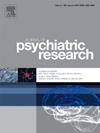Neural responses to social decision-making and their associated factors among nonsuicidal self-injured adolescents: An event-related potentials study
IF 3.7
2区 医学
Q1 PSYCHIATRY
引用次数: 0
Abstract
Objective
The neuroelectrophysiology mechanisms of the connection between nonsuicidal self-injury (NSSI) and impairment of social decision-making function remain unknown. As the event-related potentials (ERPs) technique has been widely used in neurobiology research because of its advantage of high temporal resolution, we conducted this study to explore the ERPs of decision-making function among adolescents with NSSI.
Method
This study was designed to compare patients with mood disorder plus NSSI with mood disorder patients without NSSI using a 2:1 ratio. Participants aged 12–18 years were recruited from the outpatient department of psychiatry at Nanfang Hospital. Sociodemographic and psychological data were collected. The Ultimatum Game, a task examining individuals' social decision-making, was conducted with the ERP technique to record participants’ neural responses. The associations between ERPs characteristics and psychological factors were examined by using correlation analysis and regression analysis.
Results
In total, 90 participants were eligible, with 60 in the NSSI group and 30 in the non-NSSI group. N1 latency in the unfair condition was positively correlated with Difficulties in Emotion Regulation Scale scores (r = 0.257), whereas P2 latency in the fair condition was correlated with agreeableness personality (r = 0.250). Regression analysis revealed that N1 latency in the unfair condition was positively associated with NSSI (ORs ranged 1.07–1.10), whereas P2 latency in the fair condition was negatively associated (ORs ranged 0.95–0.97).
Conclusion
NSSI patients tended to exhibit impairment in decision-making function including initial cognitive value judgment, attentional allocation, and working memory process. ERPs characteristics including N1 latency and P2 latency may be predictors of NSSI.
求助全文
约1分钟内获得全文
求助全文
来源期刊

Journal of psychiatric research
医学-精神病学
CiteScore
7.30
自引率
2.10%
发文量
622
审稿时长
130 days
期刊介绍:
Founded in 1961 to report on the latest work in psychiatry and cognate disciplines, the Journal of Psychiatric Research is dedicated to innovative and timely studies of four important areas of research:
(1) clinical studies of all disciplines relating to psychiatric illness, as well as normal human behaviour, including biochemical, physiological, genetic, environmental, social, psychological and epidemiological factors;
(2) basic studies pertaining to psychiatry in such fields as neuropsychopharmacology, neuroendocrinology, electrophysiology, genetics, experimental psychology and epidemiology;
(3) the growing application of clinical laboratory techniques in psychiatry, including imagery and spectroscopy of the brain, molecular biology and computer sciences;
 求助内容:
求助内容: 应助结果提醒方式:
应助结果提醒方式:


